#cumin seeds in cooking
Explore tagged Tumblr posts
Text
#cumin seeds#health benefits of cumin#culinary uses of cumin#nutritional value of cumin#cumin seeds for digestion#cumin seeds in cooking#medicinal properties of cumin#cumin seeds and weight loss#spices for health#cumin seed recipes
0 notes
Text
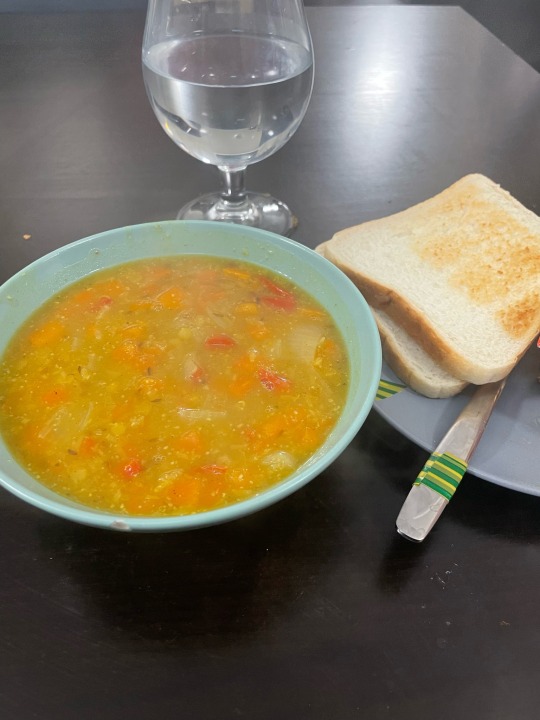
hrngh…. soup…..
#I made this!#ingredients include: butter. cumin seeds. ground cumin. garlic granules#curry powder. katsu curry granules (they were in the Aldi middle isle. I mainly put them in because they have a thickening agent in)#1 red pepper. lots of carrot. 1 huge onion. 2 veg stock cubes#oh and 1 orange’s worth of zest#it was nice#kinda wish I had a handheld blender to make it smooth but it was nice anyway#I meant to put in potatoes too but my pot wasn’t big enough#soup#cooking
14 notes
·
View notes
Text
Chicken Sukka Recipe
Flavorful Chicken Sukka Delight.Prepare to tantalize your taste buds with this easy and delicious Chicken Sukka recipe. Bursting with aromatic spices and succulent chicken, this dish is a perfect companion to both rice and roti. Follow the simple steps below to create a flavorful culinary masterpiece. Ingredients:– 400g chicken, cleaned and washed– Salt, to taste– 2 teaspoon ginger-garlic paste–…
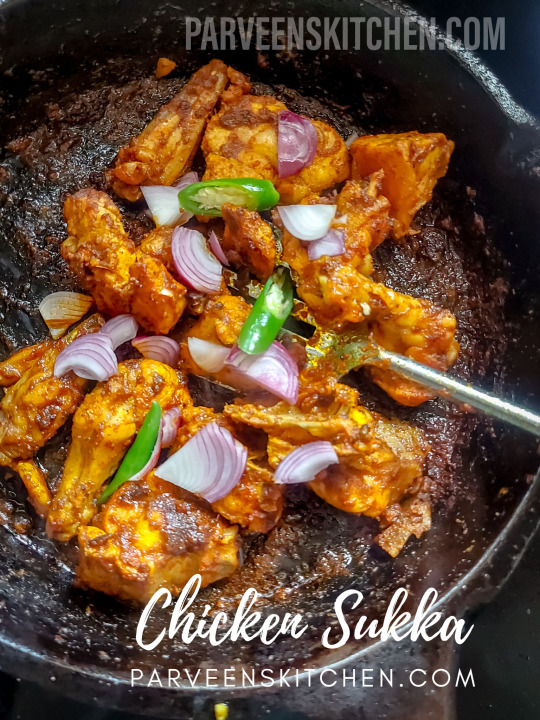
View On WordPress
#Cast iron pan#Chicken Sukka#Cooking#cumin seeds#Easy#Flavorful#Ginger Garlic Paste#green chilli#Ground peppercorn#Lemon juice#Marination#olive oil#Recipe#Red Chilli Powder#rice#Roti#Sauté#Simple#Sliced onions#Spices#Turmeric
2 notes
·
View notes
Text
Making kimbap peacefully and while reaching out for the lovely sesame oil, my 5ft ass in hindsight couldn't see the jar of cumin stacked on top of another jar that happened to be next to the sesame oil and I knocked it off and the lid of cumin jar was loose and-
My kimbap rice was littered with cumin.
Tasted more Indian than Korean
fml.

#kitchen fuck ups#kitchen disaster#cooking mistakes#mishaps#tomfoolery#short people problems#height issues#lololol#wordblr#rants#mistakes#funny stuff#my life#cumin seeds#all over the place#kimbap#cumin doesn't taste good raw#my kimbap is ruined#but alas#I have to eat it#sobbing#crying#screaming crying throwing up#words#words words words#my post#messy house#mom is not pleased#but she enjoys my misery#like
1 note
·
View note
Text
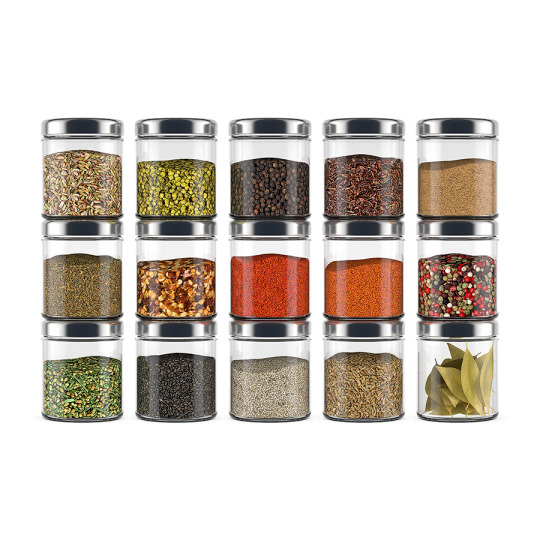
#spices#food#food and drink#spice rack#salt and pepper#seasonings#herbs#spice market#culinary#recipe#cooking#baking#flavour#curry#condiments#spice trade#coriander#cloves#nutmeg#black pepper#cumin#cardamom#chilli pepper#allspice#mustard seed#savoury#ginger#fennel#bay leaves#spice blends
1 note
·
View note
Text
Argentinian Empanadas Recipe - The GialloZafferano Recipe
Argentinian Empanadas Recipe – The GialloZafferano Recipe Characterized by the typical crescent shape and a varied and tasty filling, Argentine empanadas are a traditional street food widespread in many South American countries. The recipe changes not only from state to state, but also from province to province, as well as from family to family: chef Matias Perdomo explains how to make the most…
#00 flour#Argentine empanadas#Beef#Black pepper#Boiled eggs#cooked#Copper onions#Cumin powder#Extra virgin olive oil#Green olives#It goes up fine#kitchen#Lard#Oregano#recipe#Recipes#Red peppers#Sunflower seed oil#Waterfall#White wine vinegar
0 notes
Text
youtube
From its historical significance to its scientifically proven benefits, black cumin seed has captured the attention of health enthusiasts worldwide. Join us as we explore its remarkable properties and how it can enhance your overall well-being.
Black cumin seed, also known as Nigella sativa, has been used for centuries in traditional medicine systems across various cultures. Renowned for its potent medicinal properties, this tiny seed packs a powerful punch when it comes to promoting health and vitality. Throughout history, it has been revered for its ability to address a wide range of health concerns, from digestive issues to respiratory ailments.
In this enlightening video, we'll uncover the diverse array of health benefits associated with black cumin seed. From its anti-inflammatory properties to its potential role in supporting immune function, we'll explore the science behind its efficacy. Additionally, we'll discuss how black cumin seed oil, extracted from the seeds of the Nigella sativa plant, has become increasingly popular as a natural remedy for various health conditions. One of the most intriguing aspects of black cumin seed is its rich nutritional profile. Packed with essential fatty acids, vitamins, minerals, and antioxidants, this superfood offers a wide range of nutrients essential for optimal health.
We'll take a closer look at the nutritional composition of black cumin seed and how it can contribute to a balanced and vibrant lifestyle. Furthermore, we'll examine the role of black cumin seed in promoting cardiovascular health and supporting weight management goals. With its potential to regulate cholesterol levels, improve blood sugar control, and enhance metabolic function, black cumin seed has emerged as a promising ally in the fight against chronic diseases. But the benefits of black cumin seed extend beyond physical health. We'll explore its potential to support mental well-being and cognitive function, shedding light on its mood-stabilizing and neuroprotective properties. In an era marked by increasing stress and mental health challenges, the holistic benefits of black cumin seed offer a ray of hope for those seeking natural solutions to support emotional resilience and vitality.
In addition to its therapeutic properties, black cumin seed has garnered attention for its culinary versatility. We'll share creative ways to incorporate black cumin seed into your daily diet, from sprinkling it over salads to infusing it into smoothies and savory dishes. With its distinct flavor profile and aromatic essence, black cumin seed adds a unique twist to culinary creations while delivering a wealth of health benefits.
As we navigate the vast landscape of natural remedies and superfoods, black cumin seed stands out as a beacon of holistic healing and wellness. Whether you're seeking to enhance your physical vitality, support your mental clarity, or simply embrace a healthier lifestyle, black cumin seed offers a compelling solution rooted in ancient wisdom and modern science.
Find more Videos on YouTube: FoodieFlavorscape
#blackseed#black cumin seed#spices#natural remedies#nigella stevia#food facts#black cumin seed benefit#cooking#health and wellness#spice profiles#cooking tips#Youtube
0 notes
Text
This is also a bit of a culture query, cos these are all in my house so I genuinely cook with these all (except chicken salt, that's been in my cupboard for ages)
But I'm not from the USA and most people here are, so I wonder if that's similar! Maybe your cupboard is identical to mine. Maybe we use the same stuff but call it something else. Maybe USA has a different relationship with pre mix spices and you use none of it. Maybe you've never heard of pre mix spices. I dunno. That's why I'm asking!
I use plain herbs and spices as well. Especially when making a complex meal I'll do it myself. But I use pre mixes other times, so I'm voting. Voting for a pre mix doesn't mean you don't also use paprika! If you genuinely have no pre mixes in the kitchen tho, then hell yeah, tell me!
Also, I know I haven't listed everything in the world. One, that's impossible. Two, this is a bit of a culture thing so I just checked my kitchen and used those. This selection is representative of me only
(you don't have to be from the USA to vote, obvs, we just all know that's how the results will end up. Please tell me about your spice mixes in other countries!!)
Morrison spice blend: Pepper, tumeric, ginger, cardamom, parsley, salt
Chinese five spice: Star anise, cinnamon, clove, fennel, Sichuan pepper
Chicken salt: Salt, chicken stock, garlic, paprika, pepper, onion, celery
Gluhwein gewurz: Orange peel, cinnamon, lemon peel, star anise, hibiscus, clove
Chimichurri: parsley, garlic, oregano, vinegar, chilli, salt, pepper
Za'atar: thyme, cumin, coriander, sesame seeds, sumac, salt, chilli
Garam masala: coriander, cumin, cardamom, cloves, pepper, cinnamon, nutmeg
#food mention#poll#polls#spices#cooking#my gut instinct says I'm going to be told about some seasonal pumpkin spice blend for the next week#but we don't have that here so I'm not preempting and it's not going on the poll#that a regional thing! that's not in Australia! I'm standing my ground#and hey maybe I'll be wrong#if you're interested i use zaatar more than anything else#it's gentle#goes well in breakfast food when I'm cooking lazy
4K notes
·
View notes
Text
Writing Notes: Herbs, Spices & Seasoning
Herbs and spices can add flavor and variety to your food.
Use a little at first, then add more when you are sure you like the flavor.
To substitute dry herbs for fresh, use ¼ teaspoon powder or 1 teaspoon crushed for 1 tablespoon fresh chopped herbs. Some herbs and spices are expensive.
You might want to buy only a few of the less expensive herbs and spices you will use.
Herbs and spices lose flavor and can spoil or get buggy if kept in the cupboard longer than a year.
If you use herbs and spices slowly, buy small containers, or store them in the freezer.
Uses of Herbs, Spices & Seasonings
Allspice - A mixture of cinnamon, nutmeg and cloves. Use in fruit desserts, pumpkin pie, apple cider, cakes, cookies, chicken, beef and fish dishes.
Basil - Tomato and egg dishes, stews, soups and salads
Bay leaves - Tomato dishes, fish and meat dishes
Celery seed - Juices, soups, salads, vegetables, pot roasts, poultry, rolls and biscuits
Chili powder - Chili, bean and rice dishes
Chives - Potato dishes, soups, dips and sauces
Cilantro - Latin American, Indian and Chinese dishes, salsa, stir fries, (Coriander leaves) legume or rice salads, hot cooked rice, grilled chicken or fish, or a dish of ripe tomatoes. Use fresh if possible.
Cinnamon - French toast, fruit and fruit salads, sweet potatoes, pumpkin and squash, puddings and apple desserts, ham or pork chops
Cloves - Whole cloves on ham or pork roast; ground cloves to season pear or apple desserts, beets, beans, tomatoes, squash and sweet potatoes
Coriander seed - Middle Eastern dishes, spice cakes and cookies, soups, roast pork and salad dressing
Cumin - Mexican, Middle Eastern and Indian dishes; beef and lamb, dry bean dishes, marinades, chili and tomato sauces; ingredient in curry powder
Dillweed - Tuna or salmon salad, potato salad, pickles, dips and sauces
Garlic - Mexican, Italian and Oriental dishes and in salad dressings; can be used fresh or dried, minced or powder
Ginger (fresh) - Oriental dishes, marinades for chicken or fish, fruit salad, dressings
Ginger (ground) - Gingerbread, spice cake, pumpkin pie, poultry or meat, soups, stews, stuffing, squash, sweet potatoes
Ground peppers: black, Cayenne & white pepper - Meats, casseroles, vegetables and soups
Italian seasoning - A mixture of marjoram, oregano, basil and rosemary; use in Italian dishes such as spaghetti
Marjoram - Egg and cheese dishes, meats, fish, poultry and vegetables
Mint - Fruit salads and fruit soups, melon, berries, cold fruit beverages, cooked carrots or peas, chilled yogurt soup, lamb, tabbouleh
Mustard - Sauces for meat and fish, in marinades, salad dressings, chutneys, pickles and relishes
Nutmeg - Cooked fruits, pies and desserts, baked items, spinach, sweet potatoes, eggnog and French toast
Onion - Any dish where onion flavor is desired; can be used fresh or dried (minced or powder)
Oregano - Italian dishes, chili, omelets, beef stew, meat loaf, pork and vegetables such as broccoli or tomatoes
Parsley - Meat, soup or vegetable dishes; adds color
Paprika - Stew, chicken, fish, potatoes, rice and hard-cooked eggs
Rosemary - Egg dishes, meats, fish, soups and stews, and vegetables
Thyme - Fish, poultry or meats, in soups or stews, vegetable salads
If these writing notes help with your poem/story, do tag me. Or send me a link. I'd love to read them!
More: On Food More: Word Lists
#word list#food#creative writing#writeblr#spilled ink#dark academia#writing prompt#poets on tumblr#writers on tumblr#literature#poetry#writing inspiration#writing inspo#writing ideas#light academia#langblr#linguistics#words#lit#writing reference#writing resources
301 notes
·
View notes
Text
Magical Oil Recipes - Protection and Warding Edition

For anyone looking to brew up some magical protections or enhance their current warding measures, here are some recipes I’ve created that you might find useful.
To prepare them, blend the ingredients in such proportions as feels correct for your purposes (or as supplies allow). Use dried material except where indicated. Place a few spoonfuls in a mason jar with a screwtop lid and fill the jar with a bland oil of your choice. (Vegetable oil of the sort you would buy for cooking works fine.) Screw the lid on tightly and shake well to combine, then leave the jar in a dark dry place for 2-4 weeks to steep.
Once steeped, prepare a clean storage bottle (also with a secure lid) and label with the type of oil and the bottling date. Strain the oil through paper towels or cheesecloth to remove the plant material, then bottle immediately. Store away from sunlight and heat for up to one year. Use for spellwork as you see fit.
(Please note that NONE of these potions are meant to be taken internally by any means. Observe all proper safety measures related to glass, fire, and potentially harmful plants as necessary during preparation.)
*- Ingredient is potentially harmful if inhaled or ingested. **- Ingredient should not be used or handled if you are pregnant or nursing.
All-Purpose Blessing Oil For blessing, purification, and consecration.
Lavender
Sweet Basil
Bay Leaf
Patchouli Note: Use Olive Oil for the base.
All-Purpose Hexbreaking Oil For general negation of baneful spells cast by oneself or others.
Agrimony**
Cinquefoil
Fennel
Vervain
Solomon's Seal Root in master bottle
And Stay Out Ward Refresher Oil For strengthening household protections between castings.
Sarsaparilla
Oakmoss
Horehound
Sweet Basil
Banned From The Premises Banishing Oil For anointing doorways and banishing unwanted persons.
Oregano
Rosemary
Lemon Peel
Thyme
Blue Moon Curse Reversal Oil For turning and countering baneful magic.
Angelica Root
Lemon Verbena
Motherwort**
Elderberries*
Change the Locks Protection Oil For protection of the home from banished persons.
Cumin
Oregano
Rosemary
Thistle
Cradlekeeper Child Protection Oil For protection of infants and young children.
Daisies (any color)
Flax Seeds
Caraway Seeds
Lamb's Ear Leaf Note: Use to anoint the lintel of the door to the child's room.
No Soliciting Front Door Oil To keep unwanted visitors away from your home.
Ivy Leaves
Sweet Basil
Blueberry Leaf
Juniper Berries Note: Apply to your front door or threshold.
Safe Space Protection Oil To help one find sanctuary when it is most needed.
Blackberry Leaf (or Tea)
Allspice Berries
Fennel Tops
Clover Leaves and Blossoms
The Shielding Light Protection Oil For passive protective magics.
Caraway Seeds
Eucalyptus Leaf**
Lavender
Vervain Note: Passive protection magic functions as a shield, rebuffing or neutralizing harm. It is good for long-term spells that don't require much energy or maintenance.
The Shining Dark Protection Oil For active protective magics.
Coconut Husk
Thistle Leaf
Witch Hazel**
Angelica Root Note: Active protection magic functions as a sword, strongly deflecting or fending off harm. This is best for short-term or immediate-use spells that are not meant to last, but must kick in very strongly and very quickly. Excellent for emergency personal protections.
The Sorcerer's Tower Protection Oil To protect your witchy supplies and workspace from interlopers.
Juniper Sprigs or Berries
Blueberry Leaf
Thistle
Astragalus Root Note: Works best alongside mundane secrecy and privacy measures. To avoid damage, anoint containers, furniture, and doors rather than items. Do not use directly on books as it may damage delicate paper or covers. Use with caution on unfinished wood.
Thorn in the Door Warding Oil To discourage unfriendly witches from entering your home.
Rosemary
Bay Leaf
Sage (any color)
Solomon's Seal Root
Rose Stem (with thorns) in master bottle
Walking Ward Protection Oil For personal warding spells of all kinds.
Sweet Basil
Witch Hazel**
Fennel Sprigs Note: This works for both active and passive protection magics and may be used in conjunction other protective oils.
Wanderlust Traveling Oil For all-purpose protection and luck while traveling.
Feverfew
Cinquefoil
Witch Hazel**
Spearmint
Should the reader require supplies, I recommend the following:
Penn Herb Company
Starwest Botanicals
Bulk Apothecary
Mountain Rose Herbs
Specialty Bottle
Photo Credit - Shaiith
All recipes are © 2017 Bree NicGarran, published in Pestlework: A Book of Magical Powders & Oils. Please check out the book if you would like more recipes.
If you’re enjoying my content, please feel free to drop a little something in the tip jar, tune in to my podcast Hex Positive, or check out my published works on Amazon or in the Willow Wings Witch Shop.
#witchcraft#witchblr#witch tips#potion recipes#potions and powders#witch community#protection magic#Pestlework
136 notes
·
View notes
Text
#cumin seeds grades#cumin seed quality#types of cumin seeds#cumin flavor#cumin aroma#cooking with cumin#cumin seed selection
0 notes
Text
I'm someone who enjoys cooking with cumin seeds. I am also someone with a passionate hatred for rice weevils. These two parts of my life are often in direct conflict with each other.
189 notes
·
View notes
Text
Slow cooker Tiffin Sambar
Delightful Slow Cooker Tiffin Sambar Recipe.South Indian cuisine boasts a vibrant tapestry of flavors, and one dish that truly represents this culinary richness is Tiffin Sambar. This dish is a perfect complement to a variety of tiffin items like dosa, idli, and vada. The best part? You can now prepare it effortlessly in a slow cooker. Today, we’ll guide you through the steps to create a…

View On WordPress
#Asafoetida#Comfort food#cumin seeds#curry leaves#dosa#Dried Red Chilli#Easy recipes#Flavorful Dish#Garlic#ghee#Healthy#Idli#Indian cooking#Indian recipes#Mustard seeds#Onion#peppercorns#Red Chilli Powder#Sambar Tempering#Slow cooked#slow cooker recipe#Soups#south indian cuisine#South Indian Flavors#Spices#Stick Blender#Tamarind#Tiffin Sambar#tomato#Toor Dal
6 notes
·
View notes
Text
Toast dried chilis like California chilis or something in the oven for like 3 minutes at like 350-400 F or something or until they’re fragrant then remove the pith and seeds and stems maybe leave some of the pith if you want it more spicy idk then pour some boiling water over them and let them soak in the hot water for 1-3 hours and then put them in a blender with the water you soaked them in then you’ve got a sauce pot right you put the blended chiles in there with some tomato sauce or paste and some water idk depends on how thick you want it and then you add a generous amount of cumin, oregano, garlic powder, salt, and pepper to it and simmer for like 10 min
You can freeze that in like 1 cup measurements in cups or bags or something. Makes for easier prep later.
Now what you do next is you get chicken thighs like enough for 3-4 people or more idk you might want leftovers, you cook the chicken in salted water or broth in a wide pan until they’re cooked through and then you shred the chicken with a fork and then you add the sauce and cook off almost all of the remaining liquid and then you make tacos out of that and it tastes really good
264 notes
·
View notes
Text







all of the wukongs ( plus the destined one ) scents! ( at least what id imagine them to be ) LMK : waterfall. mint. orchid. orange. sandlewood. pineapple. banana. hazelnut destined one : cedar leaves. river. thyme leaves. maple syrup. lavander. netflix : river stones. cherry. lake. coconut. cherry blossoms. honey. leather. cloves. BM sun wukong : cumin. wood chips. passion flower. rain forest. white sage. rain. metal scent. cooking sage. MKR : vanilla. yellow dragonfruit. dried leaves. passion fruit. rivers. wild soil and clays HIB : raspberrys. magnolia. dried leaves. anise seed. cinnamon. wild clay. rivers. NR : cloves. leather. orange marmalade. white hyacinth. coconut. rust. pine needles.
#sun wukongs!!!#made to be reposted#black myth wukong#LMK sun wukong#destined one#NR sun wukong#HIB sun wukong#netflix sun wukong#monkey king reborn sun wukong#scents#nezha reborn sun wukong#all the rest of the tags
109 notes
·
View notes
Text
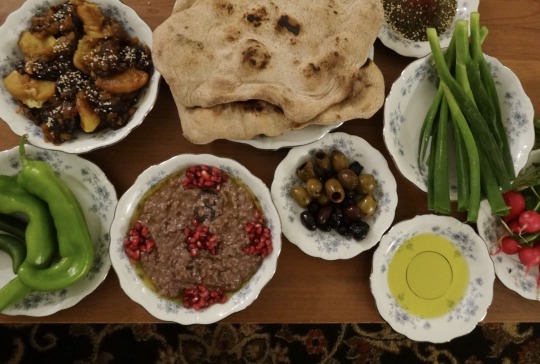
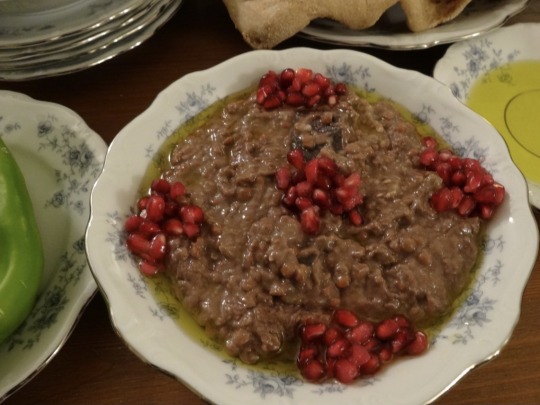
[ID: A purplish-grey stew topped with olive oil and garnished with piles of pomegranate seeds. Plates of green peppers, bitter olives, olive oil, taboon bread, green onions, radishes, and za'tar surround the dish. The second image is a close-up of the same stew. End ID]
رمانية / Rummāniyya (Palestinian pomegranate stew)
Rummaniyya (رُمَّانِيَّة; also transliterated "rumaniyya," "rummaniya," and "rummaniyeh") is a Palestinian stew or dip made from lentils, eggplant, and pomegranate seeds, flavored with nutty red tahina and a zesty, spicy دُقَّة (dugga) of dill seeds, garlic, and peppers. A طشة (ṭsha), or tempering, of olive oil and onion or garlic is sometimes added.
"Rummaniyya," roughly "pomegranate-y," comes from رُمَّان ("rummān") "pomegranate," plus the abstract noun suffix ـِيَّة ("iyya"); the dish is also known as حبّة رُمَّانَة ("ḥabbat rommāna"), or "pomegranate seeds." It is a seasonal dish that is made at the end of summer and the beginning of fall, when pomegranates are still green, unripe, and sour.
This stew is considered to be one of the most iconic, historic, and beloved of Palestinian dishes by people from Gaza, Yaffa, and Al-Ludd. Pomegranates—their seeds, their juice, and a thick syrup made from reducing the juice down—are integral to Palestinian cuisine and heritage, and images of them abound on ceramics and textiles. Pomegranates and their juice are sold from street carts and cafes in the West Bank and Gaza.
Today, tens of thousands of tons of pomegranates are grown and harvested by Israeli farmers on stolen Palestinian farmland; about half of the crop is exported, mainly to Europe. Meanwhile, Palestinians have a far easier time gaining permits to work on Israeli-owned farms than getting permission from the military to work land that is ostensibly theirs. These restrictions apply within several kilometers of Israel's claimed borders with Gaza and the West Bank, some of the most fertile land in the area; Palestinian farmers working in this zone risk being injured or killed by military fire.
Israel further restricts Palestinians' ability to work their farms and export crops by imposing tariffs, unexpectedly closing borders, shutting down and contaminating water supplies, spraying Palestinian crops with pesticides, bulldozing crops (including eggplant) when they are ready to be harvested, and bombing Palestinian farmland and generators. Though Palestinian goods have local markets, the sale of Palestinian crops to Israel was forbidden from 2007 to 2014 (when Israel accepted shipments of goods including tomato and eggplant).
Gazans have resisted these methods by disregarding orders to avoid the arable land near Israel's claimed borders, continuing to forage native plants, growing new spices and herbs for export, planting hydroponic rooftop gardens, crushing chalk and dried eggplants to produce calcium for plants, using fish excrement as fertilizer, creating water purification systems, and growing plants in saltwater. Resisting Israeli targeting of Palestinian food self-sufficiency has been necessary for practical and economic reasons, but also symbolizes the endurance of Palestinian culture, history, and identity.
Support Palestinian resistance by calling Elbit System's (Israel's primary weapons manufacturer) landlord; donating to Palestine Action's bail fund; and buying an e-Sim for distribution in Gaza.
Serves 6-8.
Ingredients:
For the stew:
1 medium eggplant (370g)
1 cup brown lentils (عدس اسود)
600g pomegranate seeds (to make 3 cups juice)
3 Tbsp all-purpose flour
1/4 cup red tahina
1/2 cup olive oil
Salt, to taste
Citric acid (ملح الليمون / حامِض ليمون) (optional)
Red tahina may be approximated with home cooking tools with the above-linked recipe; you may also toast white tahina in a skillet with a little olive oil, stirring often, until it becomes deeply golden brown.
For the دُقَّة (dugga / crushed condiment):
2 tsp cumin seeds, or ground cumin
1 1/2 Tbsp dill seeds ("locust eye" بذور الشبت / عين جرادة)
5 cloves garlic
1 green sweet pepper (فلفل بارد اخضر)
2 dried red chilis (فلفل شطة احمر)
People use red and green sweet and chili peppers in whatever combination they have on hand for this recipe; e.g. red and green chilis, just green chilis, just red chilis, or just green sweet peppers. Green sweet peppers and red chilis are the most common combination.
For the طشة (Tsha / tempering) (optional):
Olive oil
1 Tbsp minced garlic
Instructions:
1. Rinse and pick over lentils. In a large pot, simmer lentils, covered, in enough water to cover for about 8 minutes, or until half-tender.
2. Meanwhile, make the dugga by combining all ingredients in a mortar and pestle or food processor, and grinding until a coarse mixture forms.
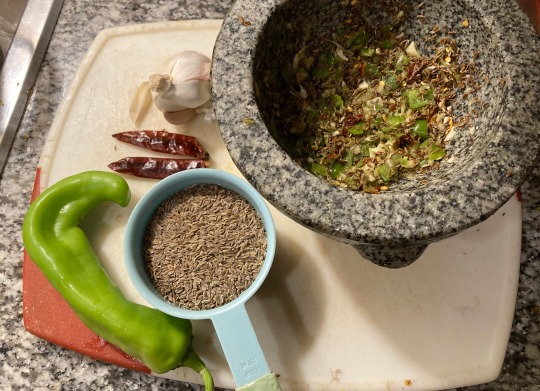
Dugga and components.
3. Cube eggplant. A medium-sized eggplant may be cut in half lengthwise (through the root), each half cut into thirds lengthwise, then cubed widthwise.
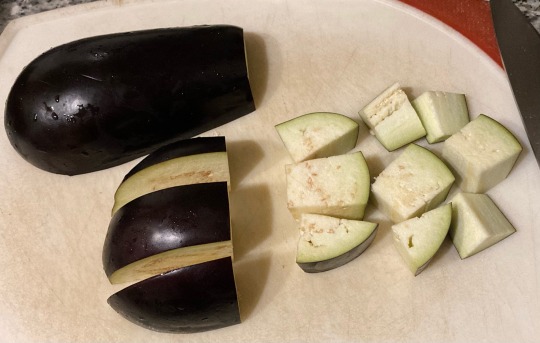
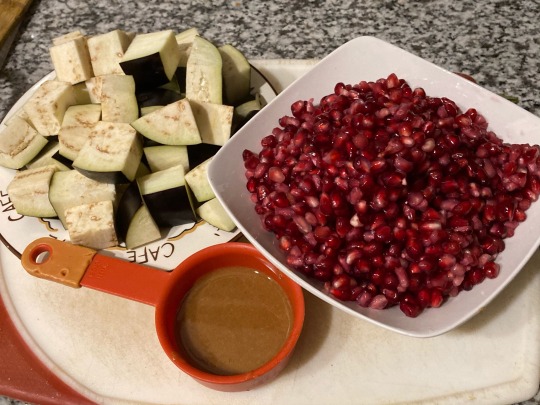
Cubed eggplant, red tahina, and pomegranate seeds.
4. Add eggplant to simmering water (there is no need to stir).
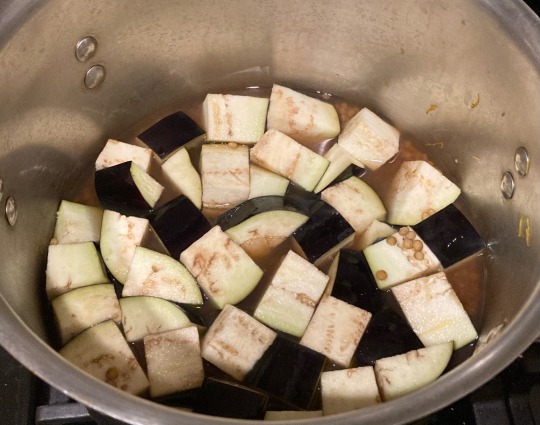
5. While the eggplant cooks, blend pomegranate seeds in a blender very thoroughly. Strain to remove any gritty residue. Whisk flour into pomegranate juice.
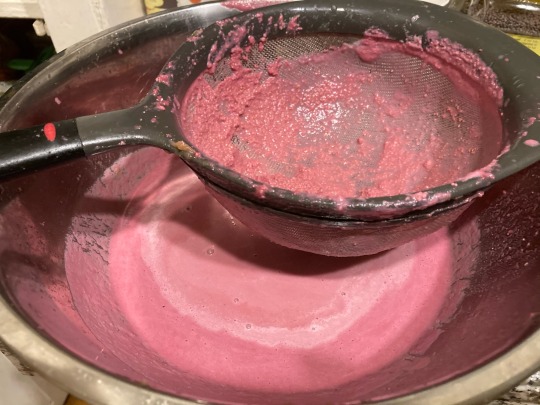
Pomegranate juice being strained.
6. Taste your pomegranate juice. If it is not sour, add a pinch of citric acid or a splash of lemon juice and stir.
7. Add dagga to the pot with the lentils and eggplant and stir. Continue to simmer until the eggplant is very tender and falling apart.
8. Add pomegranate juice, tahina, and olive oil to the pot, and simmer for another 5 minutes, or until stew is very thick and homogenous.
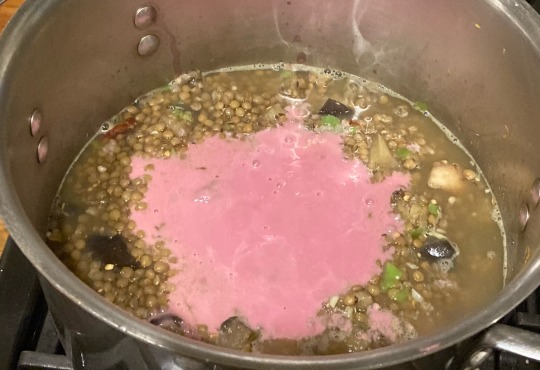
Bright pink pomegranate juice in stockpot.
9. (Optional) In a small skillet, heat a little olive oil on medium. Fry minced garlic, stirring constantly, until golden brown. Add into the pot and stir.
10. (Optional) Mash the stew with the bowl of a ladle or a bean masher to produce a more homogenous texture.
Serve rummaniyya hot or cold in individual serving bowls. It may be served as an appetizer, or as a main dish alongside flatbread, olives, and fresh vegetables such as radishes, green peppers, green onions, carrots, and romaine lettuce. It may be eaten with a spoon, or by using كماج (kmāj), a flatbread with an internal pocket, to scoop up each bite.
574 notes
·
View notes